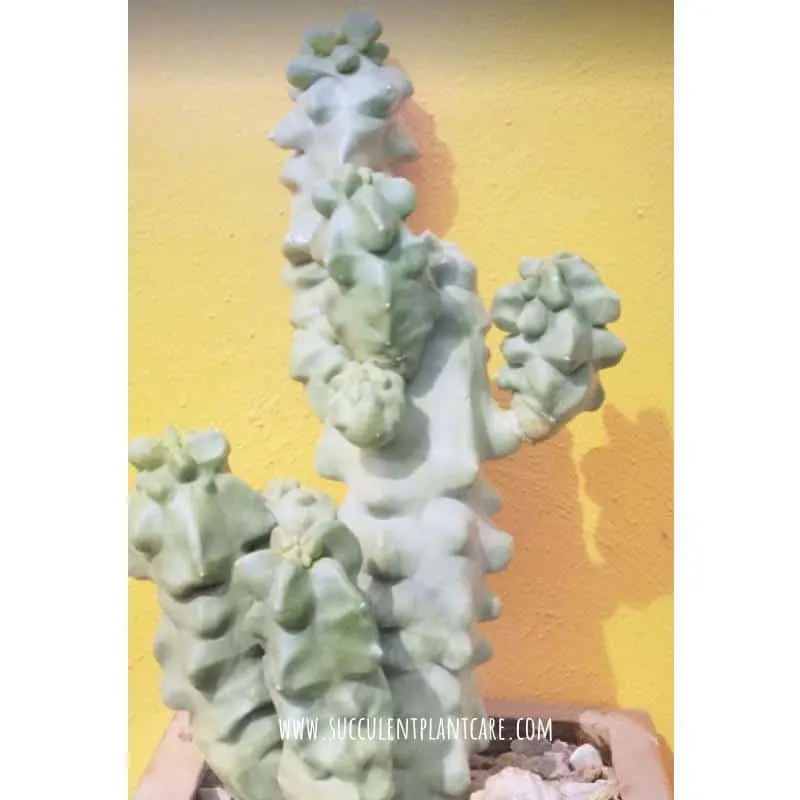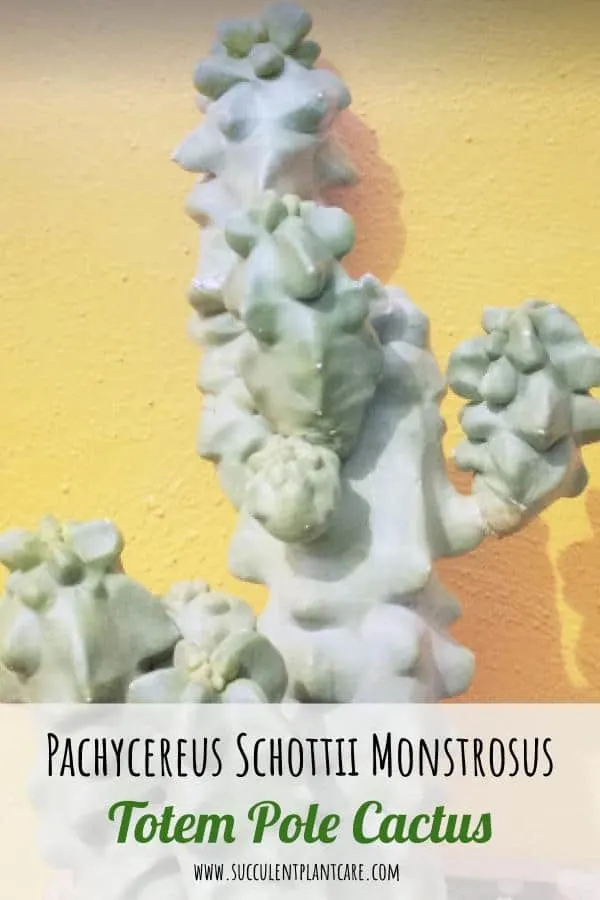The Pachycereus Schottii Monstrosus, also called ‘Totem Pole Cactus’, is a slow-growing columnar cactus that reaches up to 12ft (3.7m) tall when fully grown (even taller heights are possible). A short trunk at the base presents branched, tall stems that are smooth-skinned and light to medium green in color.
The cactus features areoles along the length of it, which are small bumps that create the appearance of having many faces etched into it – thus its common name “Totem Pole Cactus”. Each plant has between 5 and 9 ribs, spaced wide apart. The most noticeable characteristic is the hair-like sharp grey bristles covering the tips of the mature taller stems.

Is Pachycereus Schottii Monstrosus an Indoor or Outdoor Plant?
The Pachycereus Schottii Monstrosus grows naturally outdoors. This plant is popularly planted poolside, next to ponds, or as part of desert plant and rockery features. Pachycereus Schottii Monstrosus owners also often choose to show them off in cactus gardens and aesthetic containers. They also do well when planted in raised garden beds with other succulents and cactus plants, as they require minimal water and gravely, well-draining soil. If you live in a cooler area and still wish to grow your cactus outdoors, make sure that you plant it into a clay pot with a gritty cactus growing medium. And make sure that you move your plant indoors when the temperatures drop to below 50℉ or 10℃.
While this particular cactus likes growing outdoors, it can be grown indoors with proper conditions. It needs a fast-draining potting mix cactus and planted in a well-draining pot. Ensure that it is placed in a spot where it gets direct sunlight throughout the day. South-facing windows are a good option.
Indoor Lighting Requirements
The Pachycereus schottii monstrosus is a sun-loving plant and it will thrive in direct sunlight all day long. It is happiest in a warm, sunny environment and will start to show signs of distress if it is deprived of such. If you are growing the cactus indoors, make sure that you find a south facing window or the sunniest spot in the house to position it in. Do not try to keep your cactus in a room that only receives partial sunlight or an hour or two of sun per day as your plant will surely not do well.
If you must keep these plants indoors or bring them in over the winter, you have to choose the brightest area in the house. If the plant does not receive adequate lighting no matter where you move it indoors, consider using a grow light to help supplement its sunlight requirements. Grow lights can help supply the lighting needs of the plant indoors. Here are some of my grow light recommendations.
Outdoor Sunlight Requirements
Outdoors, the cactus will thoroughly enjoy growing in a colony with similar plants in full sun and with plenty of reflected heat. Provide as much sun outdoors as possible.
The Pachycereus schottii monstrosus will do very well in those areas that are too hot for other succulents and cacti. They will tolerate and thrive under direct sunlight, full sun and heat. There is absolutely no reason to concern yourself with finding a partially shady spot for the Totem Pole Cactus at all.
Frost Tolerance
While the plant does well in extreme sun exposure and heat, it cannot survive a vaguely extended period of frost. The Pachycereus Schottii Monstrosus is known to survive temperatures down to 24℉ (-4℃), but will not be able to live and grow consistently in these conditions. At these low temperatures, the plant will be busy surviving and keeping itself alive. Anything lower and the plant may barely survive. Once the temperature drops close to 24℉ (-4℃), protect the tender tips of the plant from the cold by providing some sort of covering at the tips of the plant.
Once the weather drops below 24℉ (-4℃), you need to bring the plant in for the winter or provide some protection for your plant from the cold if kept outdoors. To protect your plant from frost and freezing temperatures, you can use a blanket or a frost cloth to cover the plant. These protective coverings can help protect the plants from the freezing temperatures and help them survive the winter outdoors. Here are some of my frost protection recommendations. However, if you live in an environment with very harsh winter conditions, these cacti are best protected indoors during the winter. Just make sure they get adequate sunlight indoors.
Soil Requirements
In its native habitat, the Totem Pole Cactus can be found growing in colonies on rocky hillsides and in soft sandy and gravelly soil. It is best to plant them in a rich, porous, sandy soil that can easily dry out between watering. When potted, their soil should be refreshed every two years to ensure the plants are getting the necessary nutrients. You can make your own soil by combining cactus potting mix, perlite, and coarse sand in equal parts (1:1:1 solution).
You can find these materials in garden centers or hardware stores. To get them online, check my resource page for soil and soil amendment recommendations. The Pachycereus schottii monstrosus need to be repotted every two years or so.
Watering Requirements
The Pachycereus schottii monstrosus is very drought resistant, but this does not mean that they need no water at all. As a general rule of thumb, the larger and more established the plant is, the less water it will need. The watering needs of your Pachycereus Schottii Monstrosus will vary according to the seasons and of course, the size of the plant. An established plant may need watering once every two to three weeks in the summer months, while a younger plant may need a little more water.
Here are some of the things you need to know about watering this plant:
- In-ground plant – if your cactus is growing in the ground, a deep soak watering method is best. This is where you water the base of the plant thoroughly until it’s had a good soaking. Then you leave it alone until the soil feels dry. When using this method, you do not need to water your plant very often. Once every 10-14 days in the summer time should be sufficient. You may need to water more when the weather gets very hot or during an intense heatwave. Decrease watering when the weather cools down.
- Potted plant – if your cactus is growing in a container inside, watering once every two weeks in the summertime is a good way to start. Water the plant thoroughly and drain out any excess water that may have drained out of the pot. Do not water again until the top inch of the soil feels dry.
- Transplanted or new plant – if you are repotting the cactus or adding pieces to your landscapes and pots, do not water the newly planted specimen right away. Allow the plant to settle for at least a few days to a week in the dry soil so that the roots can recover and adapt. After that, you can water your Pachycereus Schottii Monstrosus as described above.
When temperatures drop during the winter months, watering requirements change. There is usually very little need to water the cactus during winter unless there is less than 1 inch (2.54 cm) of rainfall over a period of 30 days. If rainfall is less than 1 inch (2.54 cm), water the plant about once a month. Plants kept indoors over the winter do not need to be watered as much. Watering once a month or once every four weeks should be sufficient.

Pictures obtained from The Gardener’s Guide to Cactus by Scott Calhoun
How to Propagate & Root the Totem Pole Cactus
It is best to propagate the Pachycereus schottii monstrosus with cuttings as the plant does not flower or seed very often. While you will see flowers and fruit on the plant occasionally, they are sterile. Propagation is done by cuttings. A cutting will root quite easily and grow rather quickly, especially in comparison to a cactus seed.
- Use a sharp, clean blade or knife. When cutting, make sure you cut at an angle so that water does not collect on the stump left behind. Be careful to include one or two good areolas in the piece.
- Obtain one or more cuttings. The cuttings should be at least 3 in. (7.62 cm) long or longer.
- Once you have your cuttings, lay them out and let them dry. Keep them away from direct sunlight while drying. A scab-like callus will form over the cut areas after a few days. To prevent infection, you can dust the cut wounds on both the cuttings and the mother plant with horticultural sulfur powder. This step is optional but will help seal the cut and prevent infection from setting in. Here’s where you can find horticultural sulfur online.
- Prepare a well draining potting mix (see above for soil recommendation). Once the callus has formed, push the cut end into your potting or growing medium.
- Do not water your new cuttings right away. Wait for a few days to about a week before watering to allow the plant to settle in to its new home. Water about once a week or when the top inch of the soil feels dry.
- The cuttings will root in about 2-4 weeks or so. You can check for roots by tugging at the plant gently. If you feel some resistance when pulling, the plant has formed roots. Keep in a bright location but away from direct sunlight while rooting the plant.
- Once fully rooted, you can increase the amount of sunlight until it is fully acclimated to full sun. Adjust watering as the plant matures. See above for watering requirements.
With all this said, it is known that when a stem of the Pachycereus schottii monstrosus falls off, it will root from its side in its lying-down position. This just illustrates how easily the plant is willing to propagate and grow, with minimal fuss or care.
Pachycereus Schottii Monstrosus Blooms
Many new Pachycereus Schottii Monstrosus owners are disappointed to find that their cactus does not bloom or when it does, the faded pink flowers are not as impressive as the blooms from other cactus species. The Pachycereus schottii monstrosus blooms at night. The pink flowers open up at night and close in the morning. However, this particular cactus very rarely blooms and when it does, the flowers seem to be sterile. When they do flower, it is interesting to note that each areole can host between 6 and 8 flowers at a time.
Is the Totem Pole Cactus Toxic or Poisonous?
Although rare, the Totem Pole Cactus produces a red fruit with red pulp that is edible and non-toxic. There is no evidence to substantiate that the Totem Pole Cactus plant or its fruit and flowers are toxic or poisonous. Incidents of poisoning in adults, children or pets are unfounded at this point.
While the Pachycereus Schottii Monstrosus ‘Totem Pole Cactus’ is not the most exciting of all the cactus plant family, it is an easy-growing, reliable, low-maintenance plant that can add interest to both indoor and outdoor spaces. For these reasons, many people are interested in growing them for themselves. If you are looking for a cactus plant that thrives with minimal care, the Totem Pole Cactus is a good choice.
Wondering where to find these and other cacti? Visit my resource page for recommendations on where to purchase succulents and cacti online.
Pin this to save for later or share with others now!

